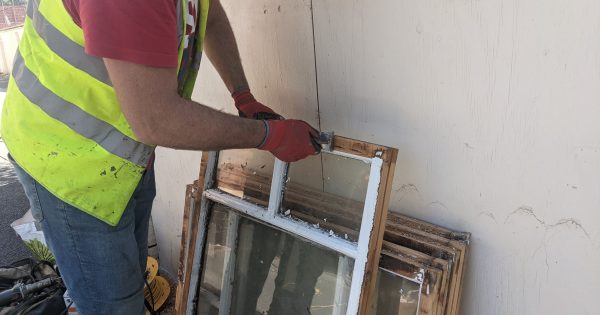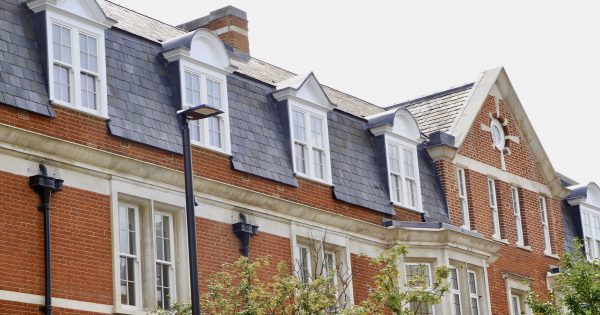Mon Sep 22
Failing sash window seals are responsible for significant energy losses and increased energy bills, uncomfortable draughts, and client dissatisfaction in heritage and high-performance buildings across the UK. Professional sealing solutions can reduce air leakage whilst maintaining the operational characteristics and visual integrity that clients expect from restored timber windows.
TRC Contracts’ Draftfix system uses rebated weatherpile seals with central fins, comprehensively tested for air tightness, water permeability and wind resistance. Our hidden sealing approach delivers measurable performance improvements without compromising the architectural character of Victorian properties or contemporary installations.
This technical guide examines the critical role of sash window seals in building performance, client satisfaction, and long-term operational success for architects, contractors and specifiers managing heritage and high-end residential projects.
Understanding seal failure and its consequences
Sash window seal failure creates multiple problems that directly impact client satisfaction and building performance. The sliding mechanism of traditional sash windows relies on precise tolerances between moving parts, making effective sealing both critical and technically challenging.
Common symptoms of seal failure include persistent cold draughts, rattling sashes during windy conditions, increased heating bills, and visible dust accumulation around window frames. These issues compound over time, leading to accelerated timber decay, condensation problems, and mounting client complaints about comfort and energy costs.
Professional assessment typically reveals seal deterioration at key locations including perimeter gaps, parting beads, staff beads, and counterbalance cavities. Understanding these failure patterns enables targeted interventions that address root causes rather than temporary fixes.
Critical sealing locations in sash windows
Parting beads and their sealing function
Parting beads represent the primary separation between upper and lower sashes, making them critical for overall window sealing performance. Traditional timber parting beads often shrink, warp, or deteriorate over time, creating significant gaps that allow cold air infiltration and reduce client comfort.
Modern parting bead replacement using materials like Accoya provides up to 35% reduction in window heat loss while improving sash movement and reducing rattling. TRC Contracts custom-manufactures parting beads to match historic profiles, ensuring visual continuity whilst integrating advanced sealing technology.
The integration of weatherpile seals within replacement parting beads creates a comprehensive barrier against air leakage whilst maintaining the smooth operation essential for daily use. This approach satisfies both conservation requirements and contemporary performance expectations.
Staff beads and perimeter sealing
Staff beads hold the lower sash in position and represent another critical sealing location. Worn or damaged staff beads allow substantial heat loss and create the rattling noise that frequently generates client complaints in heritage properties.
Professional staff bead replacement incorporates rebated seal carriers that accommodate modern weatherpile systems whilst maintaining traditional visual profiles. The rebated approach ensures seals remain hidden from view, preserving the authentic appearance that conservation officers and discerning clients demand.
Effective staff bead sealing also addresses the counterbalance cavity connections that can act as thermal bridges and air leakage paths. Proper sealing of these areas contributes significantly to overall window performance and occupant comfort.
Meeting rail and sash channel sealing
The meeting rails where upper and lower sashes overlap require specialised sealing solutions that maintain smooth operation whilst eliminating draughts. Brush seals using high-quality silicone pile strips provide flexible sealing that compresses during window closure and recovers fully when sashes are moved.
TRC’s brush seal systems use robust brass carriers with colour-matched weatherpile strips that outlast standard products whilst maintaining visual discretion. The flexible nylon bristles accommodate the slight movements and settling that occur in heritage timber windows without compromising sealing effectiveness.
Sash channel sealing prevents cold air infiltration along the vertical tracks whilst ensuring smooth window operation. Perimeter brushes installed in strategic locations create comprehensive air barriers without interfering with daily use or maintenance access.
Modern sealing technologies and materials
The Draftfix system approach
TRC’s Draftfix system represents comprehensive sealing technology specifically designed for heritage sash windows. The system combines weatherpile seals with central fins, rebated carriers concealed within beads, and perimeter brushes along with accessories that work together to achieve up to 80% reduction in air leakage according to independent testing.
Technical specifications include comprehensive testing for air tightness, water permeability and wind resistance, ensuring reliable performance across varying weather conditions. The weatherpile with central fin design provides dual-stage sealing that prevents both air leakage and dust ingress whilst maintaining operational smoothness.
All sealing components are rebated into the beading rather than surface-mounted, ensuring no visible intrusion on the window’s historic appearance. This approach satisfies conservation requirements whilst delivering measurable performance improvements that exceed client expectations.
Material selection for longevity
Professional sash window seals require materials that withstand decades of operational cycling whilst maintaining sealing effectiveness. High-quality silicone pile strips resist compression set and UV degradation, ensuring long-term performance without frequent replacement.
Brass seal carriers provide corrosion resistance and dimensional stability essential for heritage applications where replacement access may be limited. The combination of robust carriers with flexible sealing materials creates systems capable of accommodating timber movement whilst maintaining air-tight performance.
Material colour matching ensures sealing systems integrate seamlessly with existing window finishes, maintaining visual authenticity whilst delivering contemporary performance standards that satisfy modern client expectations.
Installation considerations and best practices
Workshop preparation and precision fitting
Professional seal installation requires precise routing and fitting that can only be achieved in controlled workshop conditions. TRC’s restoration process includes detailed assessment and routing of specific grooves in both upper and lower sashes to accommodate modern draught proofing systems.
Workshop-based installation ensures consistent seal positioning, proper adhesion, and quality control that field installation cannot match. The controlled environment allows for precise measurement, material preparation, and testing before windows are returned to site.
Proper preparation also includes timber repair using sophisticated systems like Repair Care alongside traditional wood plugs and splicing techniques. This comprehensive approach ensures the structural integrity necessary for effective seal performance over extended service periods.
Maintaining operational characteristics
Client satisfaction depends heavily on preserving the smooth, quiet operation that characterises well-maintained sash windows. Professional seal installation must balance air-tightness with operational ease, ensuring windows open and close with minimal effort.
The Draftfix system is specifically designed to reduce operational friction whilst improving sealing performance. Weatherpile compression during closing provides effective sealing without creating binding or resistance that would compromise daily use.
Proper seal installation also addresses rattling issues that frequently prompt client complaints. By eliminating loose tolerances whilst maintaining smooth movement, professional sealing systems deliver the quiet, refined operation that clients expect from premium window installations.
Impact on energy efficiency and client comfort
Quantifiable performance improvements
Professional sash window seals deliver measurable energy efficiency improvements that translate directly into reduced heating bills and improved client satisfaction.
The thermal performance improvements extend beyond simple draught elimination to include reduced cold bridging, minimised condensation risk, and more stable internal temperatures. These factors combine to create the comfortable living and working environments that satisfy discerning clients.
Documentation of performance improvements through before-and-after testing provides valuable evidence for building compliance, warranty purposes, and client satisfaction records. This data-driven approach demonstrates professional competence and accountability in heritage restoration projects.
Addressing condensation and ventilation concerns
Effective sash window seals must balance air-tightness with appropriate ventilation to prevent condensation problems that could compromise timber condition and client satisfaction. TRC’s approach includes discreet trickle vents where appropriate and permitted, and careful attention to background ventilation requirements.
Moisture-regulating materials in heritage wooden sash window construction help maintain healthy indoor air quality whilst minimising heat loss. This balanced approach prevents the over-sealing that can create condensation problems and associated client complaints.
Professional installation includes guidance on appropriate ventilation practices that maintain the performance benefits of improved sealing whilst ensuring healthy building conditions. Client education on this balance contributes to long-term satisfaction and system performance.
What maintenance do professional sash window seals require?
Professional sash window seals typically require minimal maintenance when properly installed. Annual inspection for damage or compression, occasional cleaning of debris from weather strips, and periodic lubrication of moving parts ensure continued performance. Quality systems like TRC’s Draftfix can provide decades of reliable service with basic care.
Integration with glazing and restoration projects
Coordinated approach to window performance
Sash window seals work most effectively when integrated with comprehensive glazing and restoration strategies. Double glazing upgrades, timber repairs, and sealing improvements should be planned together to achieve optimal performance and client satisfaction outcomes.
The combination of modern glazing with professional sealing systems can transform heritage windows into high-performance installations that exceed contemporary building standards whilst preserving historic character. This integrated approach maximises client investment and satisfaction.
Project coordination also ensures that sealing work complements other restoration activities, preventing conflicts between different trades and ensuring cohesive results that meet all performance objectives.
Colour coordination and visual integration
Client satisfaction often depends on visual details that demonstrate attention to quality and craftsmanship. Professional seal installation includes colour matching to existing window finishes, ensuring seamless integration that preserves authentic appearance.
TRC’s approach includes custom colour options that accommodate unique heritage paint schemes and contemporary colour preferences. This attention to visual detail contributes significantly to overall client satisfaction and project success.
Proper visual integration also supports conservation compliance and planning approval processes, ensuring that performance improvements don’t compromise heritage value or architectural integrity.
Quality assurance and client satisfaction
Testing and performance verification
Professional sash window seal installation includes comprehensive testing to verify air-tightness, water resistance, and operational performance. This quality assurance approach provides confidence for both installers and clients whilst establishing baseline performance data.
Testing protocols include both workshop verification and post-installation assessment to ensure systems perform as specified in real-world conditions. This thorough approach minimises callbacks and ensures client satisfaction with completed installations.
Performance verification also provides valuable data for warranty purposes and long-term maintenance planning, contributing to the overall value proposition that clients expect from professional restoration services.
Long-term support and warranties
Client satisfaction extends beyond initial installation to include ongoing support and warranty coverage that provides peace of mind for major restoration investments. TRC Contracts offers up to 10-year guarantees on draught-proofing systems, demonstrating confidence in material quality and installation standards.
Comprehensive warranty coverage includes both material performance and installation workmanship, ensuring clients receive complete protection for their investment. This approach builds long-term relationships and supports repeat business from satisfied clients.
Professional support also includes guidance on maintenance requirements, operational best practices, and upgrade options that help clients maximise the value and performance of their restored sash windows over extended periods.
Key takeaways for professionals
When specifying sash window seals for heritage and high-performance applications, consider these essential factors:
- Prioritise hidden, rebated sealing systems that preserve historic appearance
- Specify materials tested for long-term performance in operational conditions
- Ensure installation includes proper workshop preparation and precision fitting
- Balance air-tightness with appropriate ventilation requirements
- Document performance improvements for compliance and warranty purposes
- Provide comprehensive client education on maintenance and operation
- Integrate sealing work with glazing upgrades and restoration activities
Partner with TRC Contracts for professional sash window sealing
TRC Contracts brings over 30 years of expertise in sash window restoration and sealing solutions for heritage and high-performance applications. Our Draftfix system delivers proven results in Grade I and II listed buildings across the UK, combining conservation compliance with contemporary performance standards.
Whether you’re managing heritage restoration projects, high-end residential developments, or public building upgrades, our professional sealing solutions provide the performance improvements and client satisfaction outcomes that successful projects demand.
Contact TRC Contracts today to discuss your sash window sealing requirements and discover how our proven systems can deliver the energy efficiency, comfort, and long-term reliability that your clients expect from premium timber window installations.





